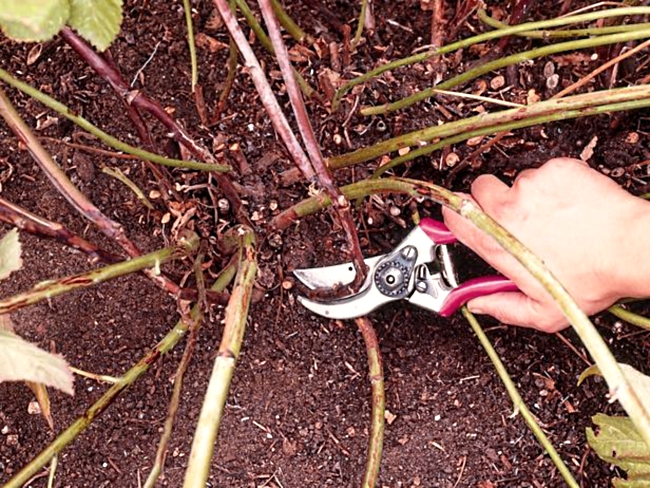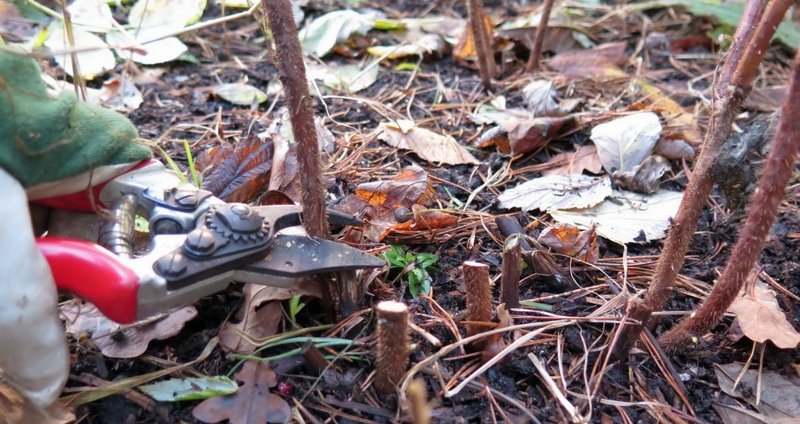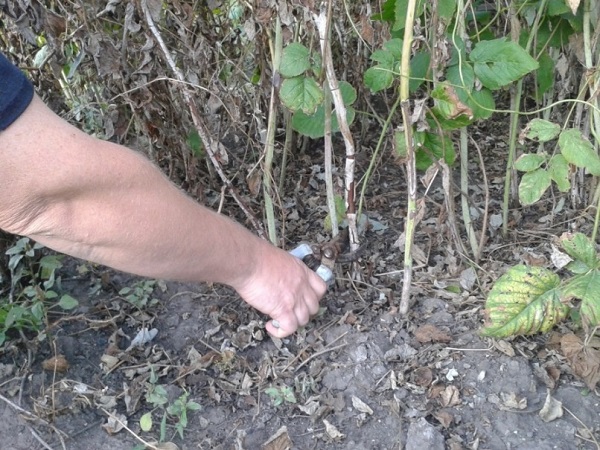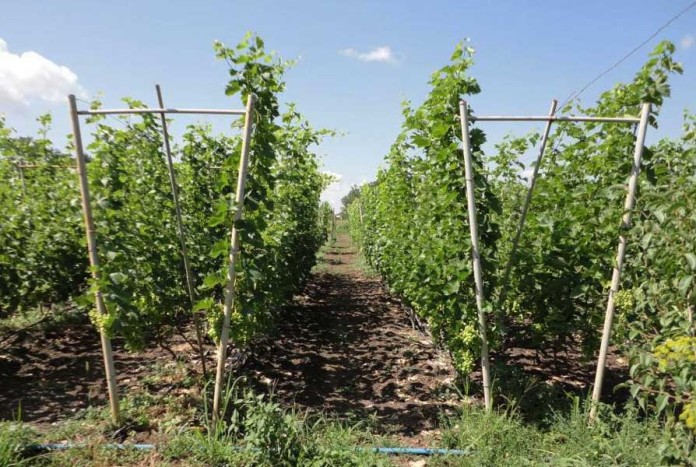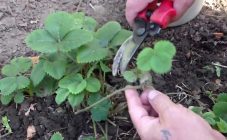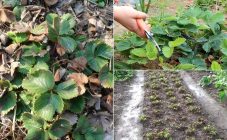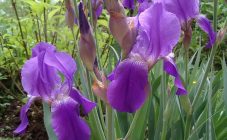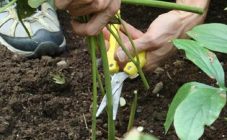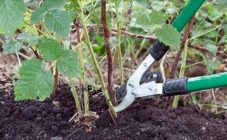Content:
Pruning is one of the essential steps in caring for berry bushes. But each type of horticultural crops differs from each other in a number of features. Therefore, it is important to know how to prune blackberries correctly in the spring so as not to harm the plant.
Why pruning blackberries
With the help of pruning, they try to form bushes, but as for blackberries (the closest relative of raspberries), this is not the main goal of the procedure, since ground shoots exist for no more than 2 years. The main focus is thinning, because the misfortune of the blackberry itself is its actively growing shoots.
In addition to thinning, the method of shortening the branches of the last year by about 2 pairs of leaves is also used. This will help improve the quality of future fruits, as well as stimulate the appearance of side branches on which berries will appear.
Every spring, it is necessary to remove excess branches so that they do not compete with the fruiting ones for the right to obtain nutrients from the soil.
Each pruning is the regulation of the physiological processes occurring in the plant. In this way, the gardener indirectly controls the transport of streams of useful components inside the bush, directing them in the right direction.
Often, timely pruning of garden blackberries in spring helps save the plant from frost. This procedure will delay the development of the ground part of the bush for at least a week and make the plant more resistant to disease.
Advantages and Disadvantages of Spring Pruning
Formation of the plant is more recommended in spring, for that there are reasons:
- thickened shrub is a fertile environment for pests to settle there and the development of fungal infections;
- extra shoots take up food, which leads to crumbling berries and a decrease in yield;
- it is more difficult to harvest fruits on thorny blackberries if the bush is too overgrown;
- but even on a thornless culture, access to the fruits must be provided so that they are better ventilated and warmed by the sun.
Some farmers believe that the disadvantage of spring pruning is the rapid growth of new shoots, which will have to be removed again. The branches left for development are empowered, and if it is a thorny bush, then the thorns on it become denser and interfere with the harvest.
When is best: spring or autumn
If the care of the berry is carried out correctly, then the branches that have hatched are cut out in the fall, before preparing the bush for the winter. But beginners in gardening forget to do this, leaving the shoots until spring. Dry thickets will become a hindrance when the summer resident begins to form a bush at the beginning of the growing season.
Pruning should be done twice a year, at the beginning of the season and at the end of the season. Each of the processes will pursue a different purpose, but in general it will help you get a good harvest from the plant.
Sanitary pruning of blackberries is especially important. If the diseased branches and those affected by insects are not removed in the fall, then pests and bacteria will remain on the bush for the winter, depleting it. In the spring, it is also necessary to provide the plant with "medical assistance", removing those shoots that have not survived the winter cold or pererelya, otherwise the blackberry will start to hurt.
You can visually determine how alive a particular whip is - the necessary stems are cast with a healthy brown sheen (the frozen ones have a black tint). Feeling overwintered branches, they immediately discard rough and fragile ones, leaving only elastic ones.
Spring month and pruning dates
Spring cleaning of the bush is carried out before the buds wake up. The procedure can be started as soon as the snow melts and the air warms up to +5 degrees. The timing of the work directly depends on the region where the garden blackberry is grown:
- southerners start the procedure in March or early April;
- mid-spring is the term for the central regions;
- Siberians and Urals will have to wait for the second half of May.
If the summer resident gets ahead of time with spring pruning, then throughout the season he will have fewer problems with caring for the berry.
Instructions and scheme for pruning blackberries in spring
To understand how blackberry pruning is carried out in the spring, detailed instructions have been invented for novice gardeners. The first procedure is performed at the time of planting the seedlings - the sprouts are shortened to 25 cm. This allows the roots to develop better and gain a foothold in the area.
The first year, young bushes are given the opportunity to grow shoots, so that with further thinning there is something to choose from. Further, the scheme for forming a bush is as follows:
- in the 2nd year, in the spring, the tops of the branches of the last season are shortened so that the lateral buds are activated on them (a guarantee of a good harvest);
- also carry out sanitary pruning, removing broken, frozen and diseased stems;
- young shoots coming from the root are removed; but if they are shortened by only a quarter, then the branches will begin to grow to the sides, and they can later be used to form a new shrub;
- if in the fall of the second year, the stems that have hatched were not removed, then this should be done next spring; they are cut out at the root;
- in the 3rd year, having fixed the shrub on the trellis, thinning is carried out; this will ensure good circulation and speed up the ripening of the berries.
This scheme is maintained in subsequent years. At the same time, the gardener does not forget to replace the second-year branches that have managed to give a crop to young shoots of the next year.
How to create a compact bush
One of the types of circumcision is pinching - the removal of shoot tops. It is carried out on the branches of the current year in order to form a compact bush that will produce no worse than a spreading one.
Pinching stimulates the formation of new lateral branches on the shoot. The fruits will ripen on them. This procedure is carried out in this way:
- when the lash reaches 1-1.2 m, the crown is cut off by 10 cm;
- as soon as the side branches grow, the top of the main stem is still shortened.
Pinching on remontant varieties, in which berries appear on annual shoots, is especially justified.
Features of pruning of studless varieties
The currently popular varieties without thorns are often shortened using the following scheme:
- in the first year, the lashes are not touched, but only they are tied to the trellis - at a height of 0.5 m from the ground and 1.5 m;
- in the second year, the tops are shortened by 15 cm;
- on the third - new shoots are cut off by 40 cm.
This technique allows not only to form thornless vegetation, but also to increase the productivity of the bush.
Leaving after spring pruning
It is important not only to know how to cut a blackberry according to the rules, but also what kind of care to provide it after a traumatic procedure. First of all, the remaining branches that will produce this season are tied up on a trellis so that the sun's rays have access to the berries.
Garter
This will help to identify those stems that grow inside the shrub. They are either redirected with garters or removed so as not to provoke thickening.
Garter patterns:
- fan harness is used for upright shrubs; moreover, young shoots "settle out" from last year's - branches on the rows of wire are distributed on different sides of the frame, or the young are left erect, and last year's stems are fan-shaped and fixed on the trellis;
- for sundews, a wave garter is preferable, when peers are fixed on the upper tier of the trellis, and old shoots are tied in waves between the lower and middle rows;
- for those creeping, another strapping scheme is offered - a rope; new stems are tied directly to the rows of wire as they grow, and the procreative branches, collected in bunches, are distributed along the two lower rows of the support, horizontally directed outward from the center.
You can use the method applied to the Thornfrey variety to tie a studless dew. The works are carried out in stages and delimited between seasons. The trellis is installed on both sides of a row of bushes, and the branches in the harness are distributed as follows:
- first years are diverted to the side to one of the pillars;
- in the second season, new shoots are tied in the opposite direction.
In the fall, biennial branches are cut, and the next spring, young stems are tied in their place. And so, from year to year, there is an alternate replacement of the old ones, which have spawned, on the branches of the new season. Such a garter will provide a more comfortable harvest.
Loosening
Basic care includes regular loosening of the soil around the bushes. This will ensure good soil permeability: moisture and oxygen will be supplied to the roots in sufficient quantities.
When loosening, the closeness of the roots to the surface of the earth should be taken into account. In order not to damage them, the procedure is carried out no deeper than 15 cm.
Watering
After pruning, the bushes will need a lot of moisture, so the first weeks of watering are carried out daily (if necessary). In rainy season, these responsibilities will be taken over by nature. The control of the soil condition is important here - excessive watering stimulates root rot.
The right time for water treatments is early morning or before sunset. Daytime watering will provoke plant burns.
Spring pruning errors
Correct pruning of blackberries works for the benefit of the plant and future harvest. Wrong actions will have the opposite effect.
Common trimming mistakes:
| What requirements are violated | What does it lead to |
|---|---|
| A cut done at a wrong time | If at the time of the procedure a warm night temperature has not yet been established, this will lead to freezing of the kidneys. |
| Wrong priorities | If all young shoots are completely removed, and last year's only partially formed, there is no hope for a harvest in the season. |
| Frequency not observed | If the bushes are not thinned annually, they quickly thicken and turn into wild plants, producing small, sour berries. |
| Thinning of fruits is not carried out | It is a pity for novice summer residents to remove excess fruiting branches, hoping to take more harvest. But the effect is the opposite - the plant lacks nutrients, so the berries become smaller, and some of them crumble before they even ripen |
| No sanitary pruning | The plant has to spend a lot of energy on maintaining sick and weak shoots to the detriment of fruiting. Therefore, there is no hope for a good harvest. |
Considering these points and providing normal care for the blackberry after pruning, you can not worry about the healthy state of the berry and the amount of fruits it gives.
Tips for beginners
Carrying out the formation of a blackberry with the help of pruning, it is recommended to adhere to the following rules:
- removal and shortening of shoots is not done with your hands - broken off stems will hurt;
- pruning is done with a sharp pruner or hacksaw; at the same time, the instruments must be sterile so as not to introduce microbes and fungal spores into the cut;
- when cutting out biennials, hemp should not be left, otherwise they will rot and the whole plant will die;
- young shoots are not removed, but only pinched by 1/4 to stimulate abundant branching - fruits will form on the lateral branches; but first you have to wait until the stems grow up to 10 cm;
- in addition to trimming the tops, it is recommended to remove the lowest buds on the shoots - then more fruits will be tied on the side branches;
- partial pruning is done above the kidney, and not under it, while leaving the hemp;
- more than 10 fruiting shoots should not be kept on the bush, so as not to overload the plant;
- it is not worth leaving the autumn clipping of second years for the spring - their timely removal will allow the plant to endure the winter more comfortably;
- it is imperative to examine the entire bush and, without regret, remove thin, weak, diseased and injured stems.
Each cut is covered with garden varnish to prevent the penetration of infections and bacteria.
Timely and correct pruning will help preserve the varietal characteristics of the blackberry and avoid rebirth into wild plants. A sparse but healthy bush will give a better quality berry than a thickened and weakened one.
